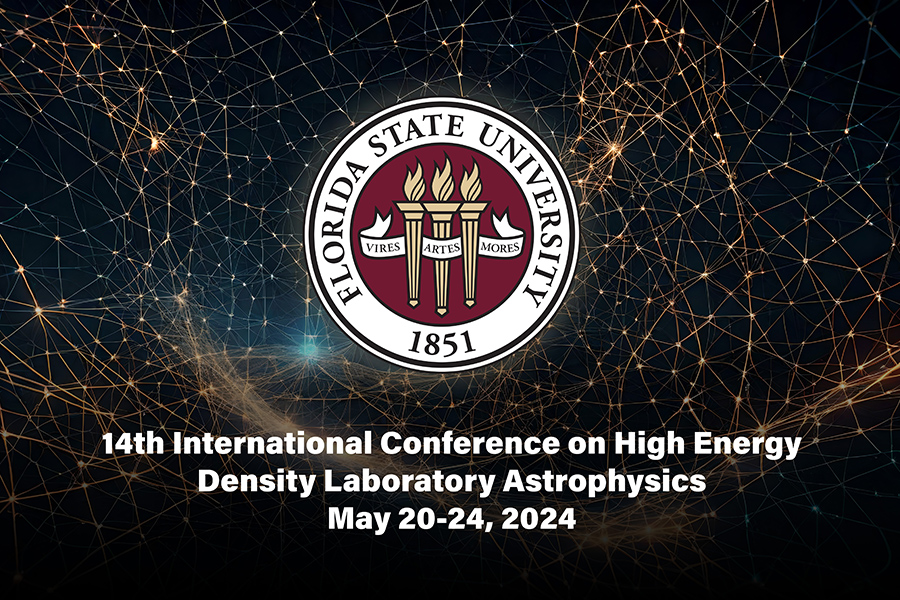
This week, Florida State University will host scientists from around the world for an interdisciplinary astrophysics conference featuring presentations from some of the field's top experts.
FSU's Department of Scientific Computing will host the 14th International Conference on High Energy Density Laboratory Astrophysics, or HEDLA, May 20-24 at the Hotel Duval in Tallahassee. The conference will welcome scientists from a variety of disciplines to discuss the most recent advancements in high energy density physics, a relatively new physics subfield comprising the intersection of condensed matter physics, nuclear physics, astrophysics and plasma physics.
"HEDLA will bring over 100 scientists from academia and government research laboratories from the U.S., Europe and Asia to FSU," said Tomasz Plewa, conference co-organizer and professor of scientific computing. "It is a chance for the university to demonstrate its support for top scientific research and for FSU researchers to develop new meaningful collaborations in science, technology, engineering and math fields."
The HEDLA conference, which is held every two years, has been hosted by institutions in the U.S., Europe, and Asia since its founding in 1996. This year's conference will provide broad coverage of recent astronomy and astrophysics progress made in experimental plasma facilities.
"HEDLA is unique in that it combines various aspects of high energy density physics and astrophysics, two seemingly different scientific fields," Plewa said. "However, these fields are not all that different, as the laws of physics are the same whether we are conducting experiments on Earth or studying a supernova explosion."
High energy density physics is a relatively new multidisciplinary field that studies matter with exceptionally high temperatures, densities, and pressures, which is a frequent occurrence in space. Astrophysical problems include the structure of planets, formation of stars, stellar evolution and stellar deaths, and extreme phenomena associated with the evolution of neutron stars and black holes. Scientific computing uses advanced mathematical computer models to solve complex science and engineering problems, and the topics and problems presented by high energy density astrophysics require supercomputer installations and sophisticated computer programs to make sense of complex equations that describe astronomical objects.
"Astrophysics is concerned with fundamental processes governing the evolution of objects in the universe as well as the evolution of the universe itself," Plewa said. "Many aspects of theoretical astrophysics, cosmology and elementary particle physics in particular, aim at probing the universe's origins and infancy, formation of the first stars and galaxies, and creation of elements required to build life as we know it."
While the concept of astrophysics may seem far-removed from daily life on Earth, some of the field's brightest minds have applied their expertise to developing sustainable, clean energy sources to ensure energy security and improve environmental protection, a topic of central interest for HEDLA this year.
Among HEDLA's notable speakers specializing in sustainable energy development is Bruce Remington, a distinguished member of the technical staff at Lawrence Livermore National Laboratory in Livermore, California. Remington studies fusion energy science, an interdisciplinary field focused on developing an energy source based on controlled thermonuclear fusion reactions, which is the same type of reaction that powers the sun and other stars.
The conference banquet speaker is Daniel Casey, a physicist at the Lawrence Livermore National Laboratory. Casey, who works with Remington, earned his doctorate from the Massachusetts Institute of Technology in 2012, and he won an Early Career Research Program award from the U.S. Department of Energy Office of Science in 2023. During the HEDLA banquet, Casey will discuss recent results and prospects of creating sustainable energy sources on Earth using stellar-like, thermonuclear reactions, which are created by fusing hydrogen and helium isotopes with some of the world's most powerful lasers.
"I hope the conference fosters collaborations among many researchers and also interaction between graduate students and established researchers," said Peter Beerli, chair of the Department of Scientific Computing. "Research institutions such as FSU as well as our department should lend a hand in organizing conferences such as HEDLA that foster research idea exchanges and collaborations among faculty at many different institutions and across the world."
To learn more about the HEDLA 2024 conference, visit hedla2024.sc.fsu.edu






